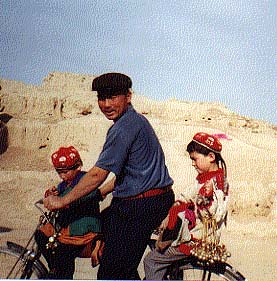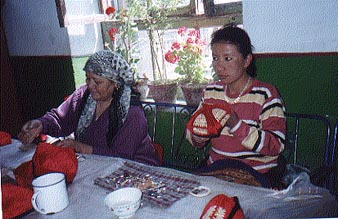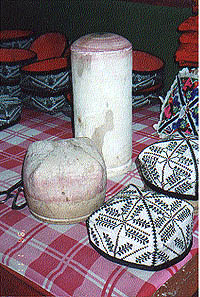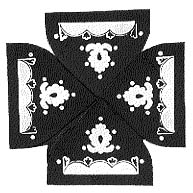| Object
in focus |

|
The
caps of the Uighur people
Throughout
Central Asia men, women and children wore caps as an integral
part of their traditional dress. This Object in focus
describes the design and manufacture of the cap worn by
the Uighur people of China's Xinjiang province.

Photo: Adrienne Cobby |
 Photo:
Adrienne Cobby
Photo:
Adrienne Cobby |
Making Uighur caps
The
wearer's age, sex and profession are often indicated by
the style and design of their caps. The shape of the cap
is described as square rounded, and most caps are
designed to be folded flat for convenience. The outer layer
of the caps is made in two sections:
- square
top section
- rectangular
headband section. This piece joins together to form the
main body of the cap.
Embroidery techniques
A variety of embroidery techniques are used to make these
colourful caps. Some examples are:
- satin
stitch
- gold
and silver filigree
- sequins
- beading
- stem
stitch
- petit
point
- plaiting.
and
a combination of these techniques.
 Photo:
Adrienne Cobby
Photo:
Adrienne Cobby |
 Photo:
Adrienne Cobby
Photo:
Adrienne Cobby |
Steps in cap making
| 1.
Embroidery is worked on the two flat surface sections
of fabric. These are usually fused to plain cotton fabric
for stability while being embroidered. |
|
| 2.
The two sections are stitched together. |
|
| 3.
A red cotton lining is made separately from two pieces
of fabric quilted together. Strips of paper twisted
around a long needle are inserted between the parallel
rows of running stitch. This gives the lining of the
caps its subtle ridges. |
|
| 4.
The caps are shaped on a block and painted with starch
inside to give them body. |
 Photo:
Adrienne Cobby
Photo:
Adrienne Cobby |
| 5.
Finally they are edged in black velvet. |
|
Motifs
and design
The designs are drawn mainly from nature. The motifs are
stylised images of the stars and the moon, flowers, fruits,
birds and insects. Some specific examples are shown below:
| Fruits |
Plants |
Birds |
Insects |
| Peach |
Cotton
boll flowers |
Sparrows |
Silkworms |
| Apricot |
Almond |
Roosters |
Butterflies |
| Pomegranate
|
Wheat
ear |
Ducks |
|
| |
Beans |
|
|
Cap
designs
The designs of the caps vary greatly, but generally consist
of a motif repeated on all four sides. The caps can be divided
into four categories:
| Mampu:
one or two motifs worked with another motif and a lace
motif. Usually worked in satin stitch with bead inlay.
The background is mainly dark. |

|
| Kimam:
small scattered motifs either linked by veins or separated
by lines. This is the design on the embroidered cap
in the table above. |
 |
| Almond:
the stone of the almond is the source of the motif's
shape. One end is rounded, the other is pointed. Motifs
are usually arranged top to tail in a circle. The embroidery
is usually black with white. |
 |
| Cross:
a cross at the central point with a series of symmetrical
motifs arranged within an asterisk or square. The composition
is compact and the colours rich. |
 |
Regional
variations
As with other items of clothing, there are often regional
variations in cap design. The major variations are summarised
below.
| Hetian
region |
Famous
for its women's caps featuring a stitch similar to petit
point. They are colourful and geometric in design. |
|
Hashi region |
Noted
for men's almond cap designs. |
|
Kuche region |
Known
for the arch-topped women's caps with bead inlay. |
|
Hami region |
Influenced
by the Han culture, with such motifs as waves, clouds,
waterlilies, plums and chrysanthemums. |
|
Turphan region |
The
agricultural abundance of the region is reflected in
the flowery nature of the designs. |
|